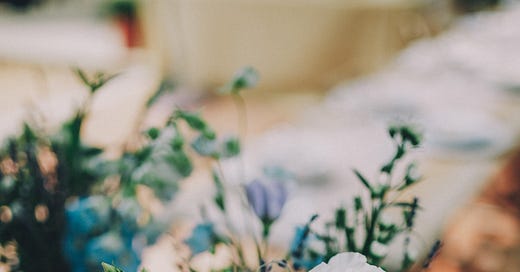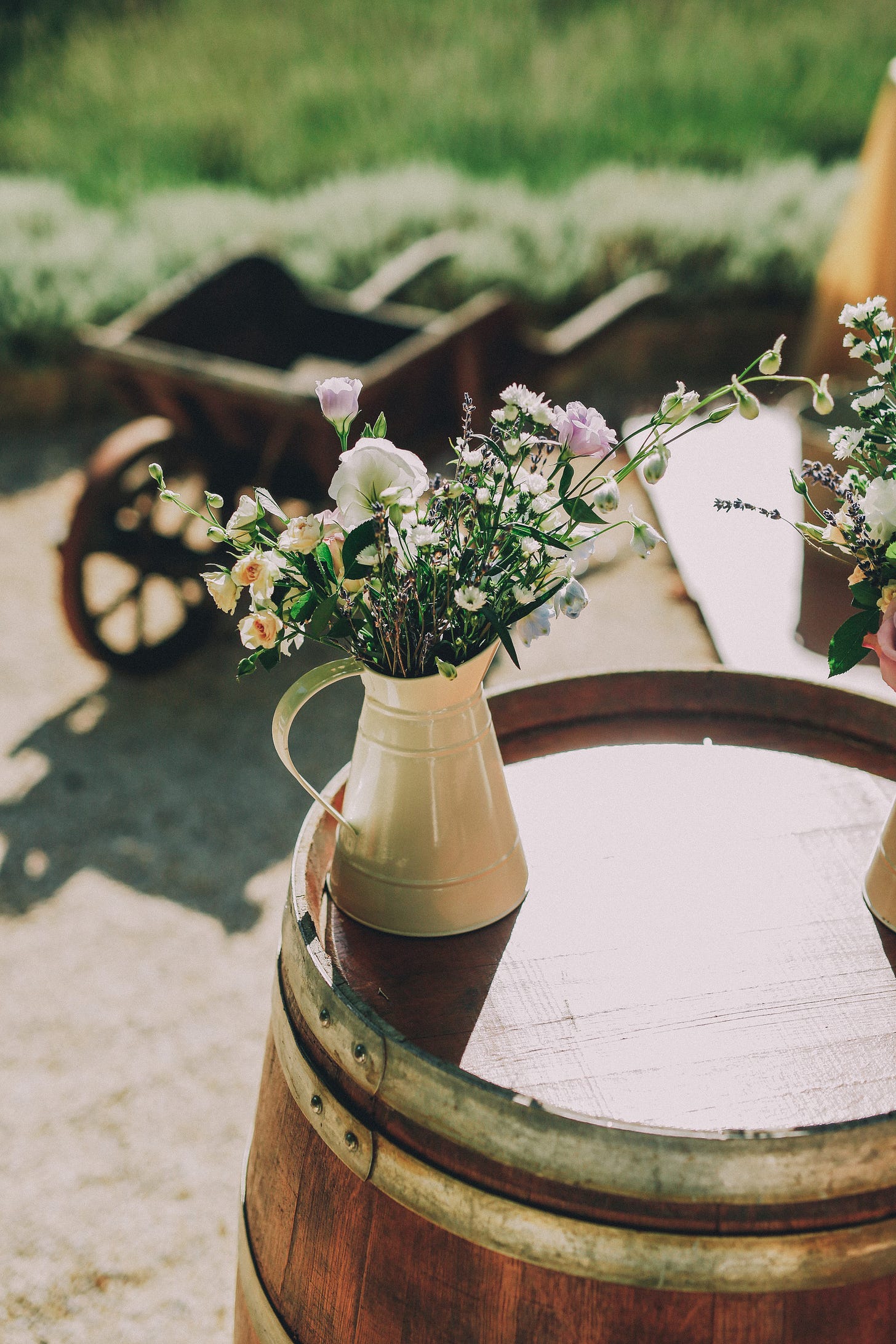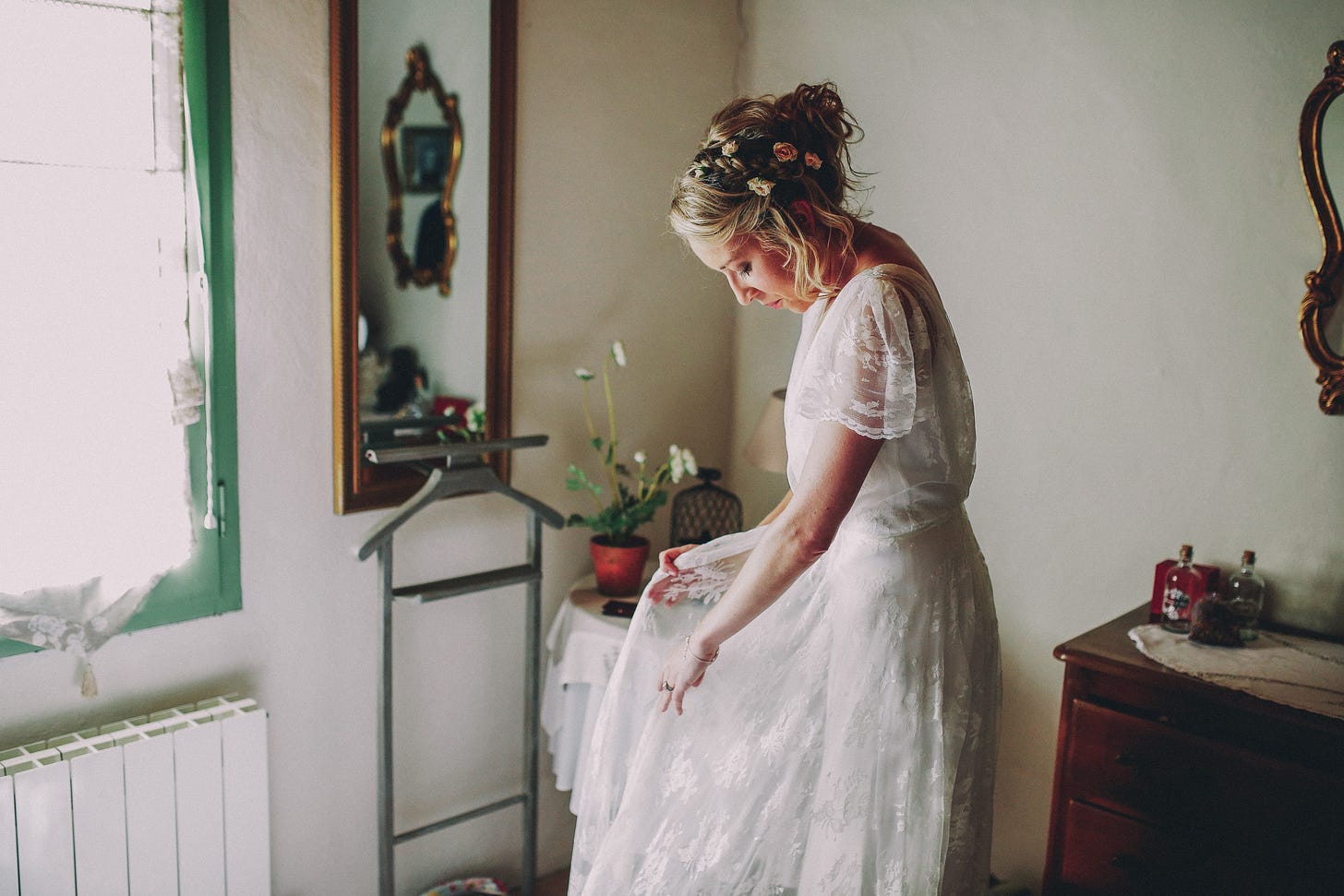Enchant yourself in summer with the love and lore of July flowers.
July's floral oracle, finding wholeness, joy and expansion with flower love and lore.
A warm hello to some beautiful new faces that have joined us recently, I am so glad you have found your way here… I’m Lyndsay — mother, creative and storyteller with a background in interiors PR. Step inside Story & Thread., a cosy, layered home where the threads of creativity, interiors and mothering meet. Here, we unearth the stories from the seasons of our lives, with a house & a garden at the heart, and everyday beauty as our guide.
“Let July be July.
Let August be August.
And let yourself
just be
even in
the uncertainty.
You don’t have to fix
everything.
You don’t have solve
everything.
And you can still
find peace
and grow
in the wild
of changing things”.
—Morgan Harper Nichols.
Hello dear reader
How has your week been and how is July feeling to you?
I have resolved to take the idea of a pause in the dance of summer into the whole of July, finding some stillness in the eye of the storm and making space for wildness without the need for forward-motion — we are still inhabiting a moment that is after the growth seasons, and before the harvest.
Over here it is the closing of one (preschool age) chapter before the start of a significant new school-shaped one. It feels like an in-between time to feel into joy, to play and to simply be in it all.
Today I am gathering three July flowers, their meanings and their messages for us all. I loved hearing about your favourite summer flowers and how many of them are pinned to a memory or a feeling. Thank you , , , , , , and for sharing yours….
The flower oracle — a spread for July.
rose | larkspur | sweet pea.
wholeness | joy | expansion.
July brings a sense of wild abandon, there is a sense of everything becoming a little more dishevelled, loose and free.
In the garden, there has been a lull, but it is now awash with new colour and fragrance after the frenzied growth brought about by recent rains. Clusters of jasmine stars shimmer with scent; vibrant trailing pelargoniums pour over the garden table; hydrangeas appear as chalky puffs in all shapes and sizes; cosmos ‘Cupcakes’ are perfect pleated saucers balancing on a stem, and roses still hold onto tightly to buds of hope, under a gentle waxing moon…
Seedlings of calendula, gypsophila, sunflower, nigella and larkspur are lined up waiting to go into the ground (I have been holding off for fear of slugs and snails…!) but the sweet peas sown from seed have taken off in exhilarating fashion — they climb and tumble in equal measure, their frilly flowers finding their way through the mass of leafy tendrils.
I have picked out three flowers as part of a flower oracle spread for July — each is currently growing in my garden and also played a part in our July wedding in France nine years ago. Interwoven with other flowers and foliage, I chose roses, larkspur and sweet peas for my bouquet before I knew much about them. It is now that I realise that the combination of the three brings a sense of wholeness, joy and expansion with an underlying sense of wildness — all qualities I wish to bring into these July days…
Messages from July flowers…
Rose — step into wholeness.
“Come out here where the roses have opened.
Let soul and world meet.”
—Rumi.
Rose (botanical name Rosa) of the genus Rosa, in the family Rosaceae. Old English rose, from Latin rosa, probably via Italian and Greek dialects from Greek rhodon.
In early summer, the climbing rose in our garden bursts to life. It starts slowly and then one by one the flowers open — unfolding, cascading and pooling around the mint green bench. There are still a handful of blooms drifting amongst the leaves, and there is always the hope that these are not to be the last. On the streets around us, statuesque shrub roses flank pavements, whilst a profusion of unruly and unkempt wild-looking roses spill over garden walls and clouds of tightly held roses in pale tones with shaded edging drape over fences as if painted onto a chintz floral fabric from another time.
The rose feels enduring, nurturing and primordial, dating back 35 to 40 million years — it represents wholeness and fullness. It is both wild and carefully cultivated; its petals spill open generously and yet there is a sharp reminder of its protective boundaries and sense of secrecy (the term sub rosa meaning, ‘under the rose,’ from the ancient use of the rose at meetings as a symbol of the sworn secrecy of the participants); there is a velvety softness and yet unwavering strength within its tough, thorny stem.
Perhaps these qualities are not the distinct, opposing entities they seem but instead remind us of our full humanity and the rich tapestry of life. Above all, the rose is said to embody the highest frequencies of love, in all its forms, and is closely associated with the ancient Greek goddess Aphrodite, Roman goddess Venus and priestess Mary Magdalene.
The rose contains multitudes, just like us. It reminds us that the multiple truths found within all of the layers, fragments and stories of ourselves co-exist to create our fullness.
The past few years immersed in early motherhood have paved the way for both an unravelling and a becoming — I am now beginning to delicately piece together all of the women I have been, and continue to be, albeit rearranged.
I am working out how each part fits together and finds its way into its rightful place, sometimes requiring a shift in orientation, or an unexpected turn — perhaps if I move slowly enough I can seal the joins with powdered gold.
*What makes up the pieces of you?
Larkspur — seek out joy in your corner of the world.
“Again the larkspur,
Heavenly blue in my garden.
They, at least, unchanged”.
—Amy Lowell.
Larkspur, of the genus Consolida, in the family Ranunculaceae. It is thought that Larkspur is said to get its name from its long petal that resembles a silver spur of a medieval knight, and the claws of the Meadowlark bird.
The larkspur plant was first introduced to Britain in the mid-1500s, from the Mediterranean, and like the rose, is both cultivated for gardens and also grows naturally, often alongside poppies and other wildflowers in cornfields. Larkspur is one of the traditional birth flowers of July (and delphinium, alongside the waterlily) and is said to represent joy, celebration and strong bonds of love. Looking back, I am so glad to have had this celebratory celestial beauty within my wedding flowers.
This year I am growing larkspur from seed for the first time — its foliage is becoming full with tiny buds reaching up, embodying the light and optimism associated with its flower-laden spires reaching skyward. According to Native American lore, larkspur is pieces of fallen sky.
Joy is a path to a more full, rounded experience than a hint of something pleasing. We can sometimes be unexpectedly overcome with joy, and at other times we have to prioritise it and actively seek it out. Joy can find us in a glimpse or passing moment, but it often leaves a lasting memory etched within.
For me, seeking joy means finding the beauty in the everyday, noticing, holding and treasuring these often simple moments with reverence and wonder. Joy also comes to me in more sustained ways when I am able to make time to immerse myself fully in the things I love — it is a feeling of being ‘in flow’ (not necessarily that things are flowing, but that I am so lost in the moment that I find myself in a deeper experience of time), or the warm, honeyed feeling of being ‘at home’, that I am exactly where I am supposed to be.
*What does joy feel like to you?
Sweet pea — expand beyond your edges and take up space.
“Here are sweet peas, on tip-toe for a flight:
With wings of gentle flush o’er delicate white,
And taper fingers catching at all things,
To bind them all about with tiny rings”.
—John Keats.
Sweet pea, Lathyrus odoratus of genus Lathyrus in the family Fabaceae (legumes). Its name derives from the Greek word lathyros meaning pea and the Latin word odoratus, meaning fragrant.
The last flower in my July triptych, is the sweet pea, a flower I have long-admired for its whimsical romance, its expansiveness and its heady scent. It is often said to bestow ‘blissful pleasure’, and is thought to be the perfect ingredient for love spells — the flower made its way into my wedding as flowers and was misted on my skin in the perfume I chose to wear on the day. In France, the flower has long been a traditional gift as a token of good luck for brides on their wedding day.
Discovered in Sicily by a monk, Franciscus Cupani in 1695, who sent sweet pea seeds to plantsmen in Europe, the sweet pea became widely grown and was introduced to the UK in 1699. Despite being a relative latecomer to the British floral landscape, it was soon adored for its simple elegance and became a floral emblem of the Victorian and Edwardian eras, with the Sweet Pea Society established in 1900.
I sowed my first sweet pea seeds this spring, into tall containers to allow the deep root growth they require, keeping them in darkness to germinate and tentatively moving them outside once the seedlings had started to grow. I finally planted them into the earth under a framework of bamboo sticks tied with the most delightful pink and purple garden twine (a gift from Great Dixter given to me by a very thoughtful friend) a few weeks ago and in the last few days a riot of delicate flowers dancing amid leaf and tendril has appeared, each beguiling in their own way. The emerging petals are enchanting, with exquisite shading as if painted by hand.
The sweet pea invites us to tap into the expansive, limitless parts of ourselves, to let go and spill over, to take up space unreservedly. They are boundless in form — there is a sense of wildness, romance, freedom and delight. They rise and fall unapologetically, without restraint, they do not hold back.
In summer, expansion feels like resting back into all of the parts of myself — those that have been dampened or feel unseen, finding fullness and stretching out beyond it all. There is a quiet trust in the climbing and tumbling, the rising and the falling, in the deep roots needed to allow for a profusion of blooms. It is meeting the edges of myself lovingly and then allowing them to melt away, making way for the golden sunlight held in my cells to trickle out from within.
*Where are you holding back? Where can you let go?
Thank you so much for reading, I would love to chat more summer flower thoughts and memories in the comments, or of course feel free to send me an email, it is always lovely to hear from you.
P.S. if you are feeling the call for more rose medicine, do feel free to delve into the Holding Stories rose-infused ceremony for summer creativity below,
Story & Thread. is an entirely reader-supported publication and I really appreciate any time you ‘like’ or choose to share words that you have felt a connection with — it means a lot to know that you are finding something of value here.
If you enjoy reading this newsletter I would be so grateful if you chose to support my writing by becoming a paid subscriber for £3.50 per month, or £35 for a year.


















What a beautiful essay Lyndsay, it’s at times almost poetic. Such a delight to read more about these beautiful flowers and the meanings behind them.
Sweet pea in French is literally Pois de senteur which means fragrant pea. Where abouts in France did you get married?
I had 3 flowers in my wedding bouquet Ranunculus, Freesias (my favourites) and I’m sad to say I can’t remember the last one. I’ll see if I can find out the missing one. I got rid of all of my wedding photos after my divorce but now I wish I had kept photos of the flowers.
Perhaps there is a reason I can’t remember the last flower because of what it represents?! xx
I feel like we are experiencing life in parallel gardens reading this post! – the tumble of climbing roses, the wild messy abandon after the rains, and the sweetpea! (mine has just started to bloom – I’m waiting for a few more to open before picking a posy – I’ll post when I do :-). So much beauty in this post – the putting together of oneself after the early years of motherhood – the larkspur as pieces of fallen sky – simple moments, being in flow – being at home. And then the sweetpeas – thank you for bringing them alive for me so much more – the expansiveness, the whimsy, the trust. In many ways they sum up summer for me – not the kind of summer I often have, or think I ‘should’ have, but what, actually I’m learning summer is offering if I take the time to slow down and look…